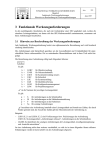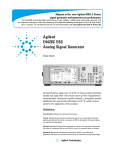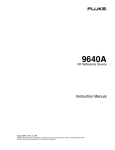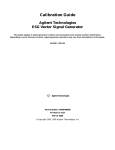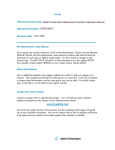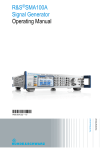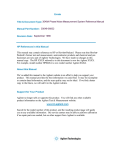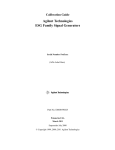Download Cross Technologies 1582-10M Technical data
Transcript
Agilent N5508A Microwave Source Hardware Reference Second edition, May 2012 Agilent Technologies Notices © Agilent Technologies, Inc. 2004-2012 Manual Part Number No part of this manual may be reproduced in any form or by any means (including electronic storage and retrieval or translation into a foreign language) without prior agreement and written consent from Agilent Technologies, Inc. as governed by United States and international copyright laws. N5508-90001 Edition Second edition, May 2012 Printed in USA Agilent Technologies, Inc. 1400 Fountaingrove Pkwy Santa Rosa, CA 95403 Warranty The material contained in this document is provided “as is,” and is subject to being changed, without notice, in future editions. Further, to the maximum extent permitted by applicable law, Agilent disclaims all warranties, either express or implied, with regard to this manual and any information contained herein, including but not limited to the implied warranties of merchantability and fitness for a particular purpose. Agilent shall not be liable for errors or for incidental or consequential damages in connection with the furnishing, use, or performance of this document or of any information contained herein. Should Agilent and the user have a separate written agreement with warranty terms covering the material in this document that conflict with these terms, the warranty terms in the separate agreement shall control. Technology Licenses The hardware and/or software described in this document are furnished under a license and may be used or copied only in accordance with the terms of such license. Restricted Rights Legend If software is for use in the performance of a U.S. Government prime contract or subcontract, Software is delivered and licensed as “Commercial computer software” as defined in DFAR 252.227-7014 (June 1995), or as a “commercial item” as defined in FAR 2.101(a) or as “Restricted computer software” as defined in FAR 52.227-19 (June 1987) or any equivalent agency regulation or contract clause. Use, duplication or disclosure of Software is subject to Agilent Technologies’ standard commercial license terms, and non-DOD Departments and Agencies of the U.S. Government will receive no greater than Restricted Rights as defined in FAR 52.227-19(c)(1-2) (June 1987). U.S. Government users will receive no greater than Limited Rights as defined in FAR 52.227-14 (June 1987) or DFAR 252.227-7015 (b)(2) (November 1995), as applicable in any technical data. Safety Notices C A UTI ON A CAUTION notice denotes a hazard. It calls attention to an operating procedure, practice, or the like that, if not correctly performed or adhered to, could result in damage to the product or loss of important data. Do not proceed beyond a CAUTION notice until the indicated conditions are fully understood and met. WA RN IN G A WARNING notice denotes a hazard. It calls attention to an operating procedure, practice, or the like that, if not correctly performed or adhered to, could result in personal injury or death. Do not proceed beyond a WARNING notice until the indicated conditions are fully understood and met. Contents 1 General Information Overview 8 Figure 1. N5508A microwave source Option 002 9 Figure 2. N5508A microwave source Standard Model Front-Panel Interfaces Figure 3. N5508A front panel 10 ACT (STATUS) 10 ERR (STATUS) 10 LSN (GPIB) 10 POWER 11 RMT (GPIB) 11 SRQ (GPIB) 11 TLK (GPIB) 11 mW LO (OUTPUT) 11 VOLTAGE CONTROL (INPUT) 12 8 9 10 Option 002 Front-Panel Interfaces 13 Figure 4. N5508A Option 002 front panel IF (OUTPUT) 14 RF SIGNAL (INPUT) 14 13 Rear-Panel Interfaces 15 Figure 5. N5508A rear panel 15 10 MHz IN 15 10 MHz OVEN OUT 16 100 MHz OUT: -2 dBm 16 100 MHz OUT: +8 dBm 16 600 MHz OUT: 0 dBm 17 600 MHz OUT: +20 dBm 17 Buffered 10 MHz Out 17 GPIB 17 IF LEVEL 18 Power Connector (~ LINE) 18 MULTIPLEXER: OUT 18 TUNE SPAN OUT 18 Agilent N5508A Hardware Reference 3 2 Technical Data General Specifications 20 Table 1. Environmental and mechanical specifications 20 Standard Model Specifications 21 RF output 21 Table 2. RF output specifications 21 Spectral purity 21 Configuration 1: all oscillators locked 22 Table 3. Configuration 1: all oscillators locked 22 Configuration 2: 100 and 600 MHz oscillators locked 23 Table 4. Configuration 2: 100 and 600 MHz oscillators locked 23 Configuration 3: 600 MHz free-running oscillator 24 Table 5. Configuration 3: 600 MHz free-running oscillator 24 AM noise 25 Table 6. AM detector noise floor specifications (+10 dBm) 25 25 Supplemental characteristics 25 Table 7. RF output supplemental characteristics 25 Figure 6. Maximum output power vs. frequency graph 26 Option 002 Specifications 27 RF output 27 Table 8. Opt. 002 RF output specifications 27 RF source 27 Spectral purity 27 Configuration 1: all oscillators locked 28 Table 9. Opt. 002 configuration 1 - all oscillators locked 28 AM noise 29 Table 10. Opt. 002 AM noise floor specifications (+10 dBm) 29 Table 11. Opt. 002 mixing spurious exceptions 29 Supplemental characteristics 30 Figure 7. 10 MHz output typical performance 30 Figure 8. 100 MHz output typical performance 30 Figure 9. 600 MHz output typical performance 31 3 Preventive Maintenance Using, Inspecting, and Cleaning RF Connectors Repeatability 34 RF cable and connector care 34 Proper connector torque 35 Table 12. Proper Connector Torque 35 4 34 Agilent N5508A Hardware Reference Connector wear and damage 35 SMA connector precautions 36 Cleaning procedure 36 Table 13. Cleaning Supplies Available from Agilent 37 General Procedures and Techniques 38 Figure 10. GPIB, 3.5 mm, Type-N, power sensor, and BNC connectors Connector removal 39 38 Instrument Removal 41 Half-Rack-Width instrument 41 To remove a half-width instrument from a system rack 41 Figure 11. Instrument lock links, front and rear 42 Benchtop instrument 42 To remove an instrument from a benchtop system 42 Instrument Installation 43 Half-Rack-Width instrument 43 To install the instrument in a rack 43 Benchtop instrument 44 To install an instrument in a benchtop system 44 Agilent N5508A Hardware Reference 5 6 Agilent N5508A Hardware Reference N5508A Microwave Source Hardware Reference 1 General Information Overview 8 Standard Model Front-Panel Interfaces 10 Option 002 Front-Panel Interfaces 13 Rear-Panel Interfaces 15 Agilent Technologies 7 1 General Information Overview The Agilent N5508A programmable microwave source is a half-rack-width System II unit that ouputs a signal between 2.4 GHz and 26.4 GHz in 600 MHz steps. The signals are output at levels from 0 dBm up to +16 dBm (+10 dBm above 7.2 GHz). The signal is derived from a 600 MHz oscillator which either free-runs or is phase-locked to a reference chain. The reference chain consists of a 100 MHz oscillator, which can be the reference or it can be phased-locked to a 10 MHz crystal controlled reference. A voltage applied to the VOLTAGE CONTROL connector can tune the reference chain. A step-recovery-diode multiplies the 600 MHz and a YIG-tuned-filter (YTF) picks off the desired frequency. The output of the YTF is amplified by a gain adjustable amplifier. This amplifier has two operating modes. One mode is for minimum noise, and the other lowers high order harmonics. . Figure 1 8 N5508A microwave source Agilent N5508A Hardware Reference General Information 1 Option 002 Option 002 adds tunable source capability to the N5508A unit. It upconverts a synthesized signal generator’s output into the 2.4 GHz to 26.5 GHz range. It has the same microwave source as the standard unit and a mixer with a second YIG-tuned filter. The tunable source can also function in the E5505A phase noise measurement system as a microwave source. Figure 2 N5508A microwave source Agilent N5508A Hardware Reference 9 1 General Information Standard Model Front-Panel Interfaces This section describes the function of the front-panel interfaces on the N5508A downconverter. Figure 3 shows the front panel. The interface descriptions appear in alphabetical order. N5508A 2.4-25.8 GHz Microwave Source RMT GPIB LSN TLK INPUT SRQ STATUS ACT ERR OUTPUT VOLTAGE CONTROL W LO POSSIBLE OUTPUT POWER +23 dBm 10 VOLTS MAX 2.4 - 25.8 GHz POWER n5508a_front_pnl 27 Apr 04 rev 1 Figure 3 NO T E N5508A front panel Some interfaces on the front and rear panels are not used for phase noise measurement, as their descriptions indicate. Their primary function is for factory testing and troubleshooting. ACT (STATUS) This LED is not used for phase noise measurements. ERR (STATUS) The error message LED illuminates when a communication error occurs and indicates that an error message is available. LSN (GPIB) The listen LED illuminates when the system addresses the instrument to listen. 10 Agilent N5508A Hardware Reference 1 General Information POWER This switch puts the instrument in active operation or standby mode. It is a standby switch and not a LINE switch. The detachable power cord is the test set’s disconnecting device. It disconnects the mains circuits from the mains supply before other parts of the instrument or system. RMT (GPIB) The remote indicator LED illuminates when the unit is enabled for GPIB control. SRQ (GPIB) The service request LED illuminates when the instrument requests service. TLK (GPIB) The talk indicator LED illuminates when the system addresses the instrument to talk. µW LO (OUTPUT) The signal at this connector is the source’s output. Limits • Frequency range: 2.4 to 25.8 GHz, in 600 MHz steps • Output power (2.4 to 6.6 GHz): 0 to +16 dBm • Output power (7.2 to 25.8 GHz): 0 to +10 dBm Characteristics • Output impedance: 50 Ω Agilent N5508A Hardware Reference 11 1 General Information VOLTAGE CONTROL (INPUT) This connector accepts an external tuning voltage from the phase noise test set for the 10, 100, or 600 MHz oscillators. Limits • Maximum voltage: ±10 V • Maximum frequency shift (10 MHz): ±0.25 ppm • Maximum frequency shift (100 MHz): ±5 ppm • Maximum frequency shift (600 MHz): ±100 ppm Characteristics • Input impedance: 100 kΩ 12 Agilent N5508A Hardware Reference 1 General Information Option 002 Front-Panel Interfaces The front-panel on the N5508A Option 002 has two additional interfaces. Figure 4 shows the front panel. The interface descriptions on page 14 appear in alphabetical order. N5508A Opt 002 Microwave Source RMT GPIB LSN TLK SRQ STATUS ACT ERR INPUT OUTPUT RF SIGNAL RF 0 TO +5 dBm 2.4-26.5 GHz VOLTAGE CONTROL POSSIBLE OUTPUT POWER +23 dBm W LO POSSIBLE OUTPUT POWER +23 dBm 10 VOLTS MAX 2.4 - 25.8 GHz POWER n5508a_opt002_front_pnl 27 Apr 04 rev 1 Figure 4 N5508A Option 002 front panel Agilent N5508A Hardware Reference 13 1 General Information IF (OUTPUT) The signal at this connector is the downconverter’s output. Limits • Nominal output level: 0 to +5 dBm (input signal ≥ –30 dBm) • Maximum output level: +15 dBm • Frequency (RF input 5 to 1500 MHz): 5 to 1500 MHz • Frequency (RF input 5 to 26.5 GHz): 300 to 900 MHz NO T E The IF amplifiers frequency response starts rolling off above 1200 MHz. Avoid using IF frequency between 1200 and 1500 MHz. Characteristics • Output impedance: 50 Ω RF SIGNAL (INPUT) This connector accepts a 120 MHz signal from a synthesized signal generator. This signal is mixed with the internal microwave local oscillator. The result is a tunable microwave signal with a 0.1 Hz resolution over most of the frequency range. Limits • Maximum input level: +10 dBm • Recommended input level: –10 to +5 dBm • Frequency: 120 to 900 MHz Characteristics • Input impedance: 50 Ω 14 Agilent N5508A Hardware Reference General Information 1 Rear-Panel Interfaces This section describes the function of the rear-panel connectors in alphabetical order. Figure 5 shows the rear panel, which is identical for the standard model and the option 002 model. 10 MHz IN 100 MHz OUT +8 dBm -2 dBm BUFFERED 10 MHz OUT 600 MHz OUT +20 dBm 0 dBm 10 MHz OVEN OUT TUNE SPAN OUT GPIB MULTIPLEXER OUT SEE USERS MANUAL ICES/NMB-001 ISM GRP.1 CLASS A N10149 SERIAL NUMBER LABEL 154258 LINE 115 V/3 A 230 V/2 A 50/60 Hz FUSE: T 3.15 A 250 V n5508a_opt002_rear_pnl 27 Apr 04 rev 1 Figure 5 N5508A rear panel 10 MHz IN This connector accepts a 10 MHz reference signal for the unit’s phase lock loops. It is normally jumpered to the 10 MHz OVEN OUT connector. Limits and characteristics • Level range: +7 to +13 dBm • Input impedance: 50 Ω Operating considerations Noise and other impurities on a signal applied to this input will show up on the output. The amount of noise and impurities passed through depends on the tuning sensitivity. Agilent N5508A Hardware Reference 15 1 General Information 10 MHz OVEN OUT The signal at this connector is the output of the 10 MHz ovenized crystal reference oscillator. It is normally jumpered to the 10 MHz IN connector. Characteristics • Typical output power: +13 dBm • Output impedance: 50 Ω Operating considerations External tuning: Tune this signal by applying a voltage to the VOLTAGE CONTROL connector. 100 MHz OUT: -2 dBm The signal at this connector is an output of the 100 MHz reference oscillator. Characteristics • Output impedance: 50 Ω • Typical output power: –2 dBm Operating considerations External tuning: Tune this signal by applying a voltage to the VOLTAGE CONTROL connector. 100 MHz OUT: +8 dBm The signal at this connector is an output of the 100 MHz oscillator. Characteristics • Output impedance: 50 Ω • Typical output power: +8 dBm Operating considerations External tuning: Tune this signal by applying a voltage to the VOLTAGE CONTROL connector. 16 Agilent N5508A Hardware Reference 1 General Information 600 MHz OUT: 0 dBm The signal at this connector is an output of the 600 MHz Output oscillator. Characteristics • Output impedance: 50 Ω • Typical output power: 0 dBm Operating considerations External tuning: Tune this frequency by applying a voltage to the VOLTAGE CONTROL connector. 600 MHz OUT: +20 dBm The signal at this connector is an output of the 600 MHz oscillator. Characteristics • Output impedance: 50 Ω • Typical output power: +20 dBm Operating considerations External tuning: Tune this signal by applying a voltage to the VOLTAGE CONTROL connector. Buffered 10 MHz Out The signal at this connector is the signal at the rear-panel 10 MHz IN connector after it has been buffered by an amplifier. Characteristics • Output impedance: 50 Ω • Typical output power: +7 dBm Operating considerations When the reference chain tuning sensitivity is set to 1.0 ppm/V, this output is switched off. GPIB GPIB communication between the source and the system occurs through this connection. Agilent N5508A Hardware Reference 17 1 General Information IF LEVEL This output connector is not used for phase noise measurements. Power Connector (~ LINE) This is the connection for the AC power cord. The detachable power cord is the test set’s disconnecting device. It disconnects the mains circuits from the mains supply before other parts of the instrument or system. For information on power requirements, see “General Specifications" on page 20. MULTIPLEXER: OUT The signal at this connector is the voltage that is measured by the internal voltmeter. Characteristics • Output level range: ±10 V • Output impedance: 1 kΩ • Bandwidth: 100 kHz TUNE SPAN OUT This connector is not used for phase noise measurement. 18 Agilent N5508A Hardware Reference N5508A Microwave Source Hardware Reference 2 Technical Data General Specifications 20 Standard Model Specifications 21 Option 002 Specifications 27 Agilent Technologies 19 2 Technical Data General Specifications This section contains environmental, mechanical, RF input, and IF ouput specifications and supplemental characteristics for the N5508A microwave source. Specifications describe the instrument’s warranted performance and apply after the warm-up period. These specifications are valid over the instrument’s operating/environmental range unless otherwise noted. Supplemental Characteristics provide additional information that is useful for operating the instrument by giving typical (expected), but not warranted, performance parameters. The specifications in Table 1 apply to both the N5508A standard model and Option 002. Table 1 20 Environmental and mechanical specifications Altitude Up to 2,000 meters (6,500 ft) Operating temperature range +0 °C to +45 °C (32 ° F to 113 ° F) Warm-up time 20 minutes Max relative humidity 80% for temperatures up to 31 °C, decreasing linearly to 50% relative humidity at 40 °C. Height 177.2 mm (7 in) Width 212.5 mm (8.4 in) Depth 574.3 mm (22.6 in) Weight ~ 33.5 lbs (15.2 kg) Agilent N5508A Hardware Reference Technical Data 2 Standard Model Specifications RF output Table 2 RF output specifications Frequency Range 2.4 to 25.8 GHz Frequency Resolution 600 MHz Ouput Power: • 2.4 to 6.6 GHz • 7.2 to 25.8 GHz 0 to +16 dBm 0 to +10 dBm Spectral purity The internal reference oscillators of the N5508A can be locked together in three configurations, each with different phase noise performance and tuning bandwidths. Table 3 on page 22 through Table 5 on page 24 provide the specifications for each configuration. All noise levels are in units of dBc/Hz unless otherwise noted. Agilent N5508A Hardware Reference 21 2 Technical Data Configuration 1: all oscillators locked Best phase noise <100 Hz frequency offsets, narrow tuning sensitivity. Refer to Table 3. Table 3 Configuration 1: all oscillators locked Output Frequency Offset From Carrier (Hz) Spurious (dBc) 11 10 100 1k 10k 100k 1M 10M 40M 10 to 100 1k to 100 MHz 2.4 to 3.0 GHz Typ. –50 –80 –100 –128 –138 –148 –152 –152 –152 –60 –80 Spec. –45 –75 –95 –123 –133 –143 –147 –147 –147 –50 –70 3.0 to 4.2 GHz Typ. –47 –77 –97 –125 –136 –146 –150 –150 –150 –54 –80 Spec. –42 –72 –92 –120 –131 –141 –145 –145 –145 –44 –70 4.2 to 6.0 GHz Typ. –44 –74 –94 –122 –134 –144 –148 –148 –148 –54 –80 Spec. –39 –69 –89 –117 –129 –139 –143 –143 –143 –44 –70 6.0 to 7.8 GHz Typ. –42 –72 –92 –120 –132 –143 –147 –147 –147 –54 –80 Spec. –37 –67 –87 –115 –127 –138 –142 –142 –142 –44 –70 7.8 to Typ. 10.2 GHz Spec. –40 –70 –90 –118 –130 –141 –145 –145 –145 –50 –80 –35 –65 –85 –113 –125 –136 –140 –140 –140 –40 –70 10.2 to Typ. 12.6 GHz Spec. –38 –68 –88 –116 –128 –140 –143 –143 –143 –50 –80 –33 –63 –83 –111 –123 –135 –138 –138 –138 –40 –70 12.6 to Typ. 18.0 GHz Spec. –35 –65 –85 –113 –125 –137 –140 –140 –140 –47 –70 –30 –60 –80 –108 –120 –132 –135 –135 –135 –37 –60 18.0 to Typ. 25.8 GHz Spec. –32 –62 –82 –110 –122 –134 –136 –136 –136 –44 –70 –27 –57 –77 –105 –117 –129 –131 –131 –131 –34 –60 1 All noise levels above -30 dBc/Hz are 3 dB below Sφ(f) expressed in dB with respect to 1 rad2/Hz. 22 Agilent N5508A Hardware Reference Technical Data 2 Configuration 2: 100 and 600 MHz oscillators locked Better phase noise <10 kHz frequency offsets, moderate tuning sensitivity. Refer to Table 4. Table 4 Configuration 2: 100 and 600 MHz oscillators locked Output Frequency Offset From Carrier (Hz) 11 10 2 100 1k 10k +2 –48 –98 –128 100k Spurious (dBc) 1M 10M 40M 100 1k to 100 MHz –138 –148 –152 –152 –145 –60 –80 2.4 to 3.0 GHz Typ. Spec. +7 –43 –93 –123 –133 –143 –147 –147 –147 –50 –70 3.0 to 4.2 GHz Typ. –45 –95 –125 –136 –146 –150 –150 –150 –54 –80 Spec. +10 –40 –90 –120 –131 –141 –145 –145 –145 –44 –70 4.2 to 6.0 GHz Typ. –42 –92 –122 –134 –144 –148 –148 –148 –54 –80 Spec. +13 –37 –87 –117 –129 –139 –143 –143 –143 –44 –70 6.0 to 7.8 GHz Typ. +10 –40 –90 –120 –132 –143 –147 –147 –147 –54 –80 Spec. +15 –35 –85 –115 –127 –138 –142 –142 –142 –44 –70 7.8 to 10.2 GHz Typ. +12 –38 –88 –118 –130 –141 –145 –145 –145 –50 –80 Spec. +17 –33 –83 –113 –125 –136 –140 –140 –140 –40 –70 10.2 to 12.6 GHz Typ. +14 –36 –86 –116 –128 –140 –143 –143 –143 –50 –50 Spec. +19 –31 –81 –111 –123 –135 –138 –138 –138 –40 –70 12.6 to 18.0 GHz Typ. +17 –33 –83 –113 –125 –137 –140 –140 –140 –47 –70 Spec. +22 –28 –78 –108 –120 –132 –135 –135 –135 –37 –60 18.0 to 25.8 GHz Typ. +20 –30 –80 –110 –122 –134 –136 –136 –136 –44 –70 Spec. +25 –25 –75 –105 –117 –129 –131 –131 –131 –34 –60 +5 +8 1 All noise levels above -30 dBc/Hz are 3 dB below Sφ(f) expressed in dB with respect to 1 rad2/Hz. 2 All noise levels above -40 dBc/Hz are 3 dB below Sφ(f) expressed in dB with respect to 1 rad2/Hz. Agilent N5508A Hardware Reference 23 2 Technical Data Configuration 3: 600 MHz free-running oscillator Good phase noise <10 kHz frequency offsets, wide tuning sensitivity. Refer to Table 5. Table 5 k Configuration 3: 600 MHz free-running oscillator Output Frequency Offset From Carrier (Hz) 2.4 to 3.0 GHz Typ. 3.0 to 4.2 GHz Typ. 4.2 to 6.0 GHz Typ. 6.0 to 7.8 GHz Typ. Spurious (dBc) 11 10 2 100 1k +15 –35 –75 –109 –138 –148 –152 –152 –152 –40 –80 –80 –105 –133 –143 –147 –147 –147 –30 –70 –70 –107 –136 –146 –150 –150 –150 –34 –74 –80 –103 –131 –141 –145 –145 –145 –24 –64 –70 –105 –134 –144 –148 –148 –148 –34 –74 –80 –101 –129 –139 –142 –142 –142 –24 –64 –70 –102 –132 –143 –147 –147 –147 –34 –74 –80 –98 –127 –138 –142 –142 –142 –24 –64 –70 –98 –130 –141 –145 –145 –145 –30 –70 –80 –94 –125 –136 –140 –140 –140 –20 –60 –70 –95 –128 –140 –143 –143 –143 –30 –70 –80 –91 –123 –135 –138 –138 –138 –20 –60 –70 –92 –125 –137 –140 –140 –140 –27 –67 –70 –88 –120 –132 –135 –135 –135 –17 –57 –60 –89 –122 –134 –136 –136 –136 –24 –64 –70 –85 –117 –129 –131 –131 –131 –14 –54 –60 Spec. +18 –32 –72 Spec. +21 –29 –69 Spec. +23 –27 –67 Spec. 7.8 to Typ. 10.2 GHz Spec. +25 10.2 to Typ. 12.6 GHz Spec. +27 12.6 to Typ. 18.0 GHz Spec. +30 18.0 to Typ. 26.5 GHz Spec. +33 –25 –23 –20 –17 –65 –63 –60 –57 10k 100k 1M 10M 40M 100 1k ≥10k 1 All noise levels above -30 dBc/Hz are 3 dB below Sφ(f) expressed in dB with respect to 1 rad2/Hz. 2 All noise levels above -40 dBc/Hz are 3 dB below Sφ(f) expressed in dB with respect to 1 rad2/Hz. 24 Agilent N5508A Hardware Reference 2 Technical Data AM noise Specifications apply for +10 dBm output power. All noise levels are in units of dBc/Hz. Refer to Table 6. Table 6 AM detector noise floor specifications (+10 dBm) Output Frequency 2.4 to 25.8 GHz Offset From Carrier (Hz) Spurious (dBc) 1 10 100 1k 10k 100k 1M 10M 40M 10 Typ. –100 –110 –117 –133 –143 –153 –155 –155 –155 –60 –80 Spec. –95 –105 –112 –128 –138 –148 –150 –150 –150 –50 –70 NO T E 1k to 40M AM noise specifications at any offset can be determined by drawing a line between specification points given on a dB-versus-log frequency plot. Supplemental characteristics Table 7 RF output supplemental characteristics Frequency Overrange 26.4 GHz with degraded output power Output Level Entry Resolution 0.1 dB Absolute Power Accuracy ±3 dB Harmonics –10 dBc Frequency Switching Transients Output power can peak at +22 dBm during frequency switching Output Power Drift <1 dB after warm-up (20 min) Output Power Settling Time <100 ms Frequency Switching Speed: • Standard • Option 002 3 seconds 6 seconds Reference Tuning Agilent N5508A Hardware Reference Voltage control of the internal reference oscillators is available through a port on the front panel. 25 2 Technical Data Table 7 RF output supplemental characteristics (continued) Tuning Range (sensitivity) Configuration 1 • ±0.25 ppm (0.05 ppm/volt) Configuration 2 • ±5 ppm (1 ppm/volt) Configuration 3 • ±100 ppm (20 ppm/volt) Tuning Port Voltage Range ±5 volts (overrange ±10 volts) Tuning Port Input Impedance • 2 kΩ Maximum Output Power vs. Frequency Figure 6 26 Maximum output power vs. frequency graph Agilent N5508A Hardware Reference Technical Data 2 Option 002 Specifications RF output Table 8 Opt. 002 RF output specifications Frequency Range Frequency Resolution: 0.1 Hz Ouput Power: o 2.4 to 6.6 GHz o 7.2 to 25.8 GHz o 25.8 to 26.5 GHz 2.4 to 25.8 GHz 2.4 to 26.5 GHz Exceptions: o 0.2 Hz: 25.84 GHz ≤ Carrier Frequency <26.1 GHz o 0.2 Hz: 26.44 GHz ≤ Carrier Frequency ≤26.5 GHz 0 to +16 dBm 0 to +10 dBm 0 to +7 dBm RF source With N5508A Option 002, the phase noise measurement system requires the addition of a synthesized signal generator. The signal generator adds the capability of mixing an RF source with the microwave source. The front-panel frequency of the RF source is automatically controlled by the N5508A unit. Spectral purity The spectral purity table (Table 9 on page 28) combines the N5508A Option 002 configuration 1 with the 8662A or 8663A synthesized signal generators when used as a microwave source. All noise levels are in units of dBc/Hz unless otherwise noted. To combine the 8662A/3A phase noise specifications with configuration 2 specifications (Table 4 on page 23) and/or configuration 3 specifications (Table 5 on page 24), use the phase noise numbers from Table 9 for offsets ≥1 kHz and configuration 2 and 3 tables for offsets ≤100 Hz. Agilent N5508A Hardware Reference 27 2 Technical Data Configuration 1: all oscillators locked Best phase noise <100 Hz frequency offsets, narrow tuning sensitivity. Refer to Table 9. Table 9 Opt. 002 configuration 1 - all oscillators locked Output Frequency Spurious (dBc)1 Offset From Carrier (Hz) 12 10 100 –50 –80 –100 –119 –121 –124 –130 –130 –135 –147 –147 –60 –80 1k 3k 5k 10k 100k 1M 10M 40M 10 to 1k to 100 100 MHz 2.4 to 3.0 GHz Typ. Spec. –43 –73 –92 –112 –112 –114 –124 –124 –130 –142 –142 –50 –70 3.0 to 4.2 GHz Typ. –47 –77 –97 –122 –129 –130 –133 –136 –141 –149 –149 –54 –80 Spec. –42 –72 –92 –115 –117 –120 –128 –131 –136 –144 –144 –44 –70 4.2 to 6.0 GHz Typ. –44 –74 –94 –120 –123 –124 –131 –136 –141 –148 –148 –54 –80 Spec. –39 –69 –89 –114 –117 –119 –126 –131 –136 –143 –143 –44 –70 6.0 to 7.8 GHz Typ. –42 –72 –92 –119 –123 –125 –130 –136 –140 –147 –147 –54 –80 Spec. –37 –67 –87 –113 –116 –118 –125 –131 –135 –142 –142 –44 –70 7.8 to 10.2 GHz Typ. –40 –70 –90 –118 –121 –124 –129 –135 –139 –145 –145 –50 –80 Spec. –35 –65 –85 –112 –115 –117 –124 –130 –134 –140 –140 –40 –70 10.2 to 12.6 GHz Typ. –38 –68 –88 –116 –121 –123 128 –134 –138 –143 –143 –50 –80 Spec. –33 –63 –83 –111 –114 –116 –123 –129 –133 –138 –138 –40 –70 12.6 to 18.0 GHz Typ. –35 –65 –85 –113 –119 –121 –125 –133 –137 –140 –140 –47 –70 Spec. –30 –60 –80 –108 –112 –114 –120 –128 –132 –135 –135 –37 –60 18.0 to 26.5 GHz Typ. –32 –62 –82 –110 –115 –117 –122 –128 –133 –136 –136 –44 –70 Spec. –27 –57 –77 –105 –108 –110 –117 –123 –127 –131 –131 –34 –60 1 Mixing an RF source with the microwave LO in the N5508A Option 002 may result in some mixing spurious exceeding spurious specifications, see Table 11, “Opt. 002 mixing spurious exceptions,” on page 29. 2 All noise levels above -30 dBc/Hz are 3 dB below Sφ(f) expressed in dB with respect to 1 rad2/Hz. 28 Agilent N5508A Hardware Reference Technical Data 2 AM noise These specifications apply for +10 dBm output power. All noise levels are in dBc/Hz. Table 10 Opt. 002 AM noise floor specifications (+10 dBm) Option 002 Output Frequency Offset From Carrier (Hz) 1 10 100 1k 10k 100k 1M 10M 40M 10 1k to 40M –97 –107 –114 –130 –140 –150 –152 –152 –152 –60 –80 Spec. –92 –102 –109 –125 –135 –145 –147 –147 –147 –50 –70 Typ. 2.4 to 26.5 GHz NO T E Spurious (dBc) AM noise specifications at any offset can be determined by drawing a line between specification points given on a dB-versus-log frequency plot. Mixing spurious • < 6 GHz: less than –60 dBc, with the exceptions shown in Table 11. • > 6 GHz: less than –70 dBc Table 11 shows the ranges in which a mixing spur occurs at less than or equal to 40 MHz from the carrier signal. Table 11 Opt. 002 mixing spurious exceptions Carrier Frequency Range (GHz)in which a Mixing Spur Occurs ≤40 MHz from Carrier Typical Spurious Level (dBc) 2.990 - 3.010 –40 2.392 - 2.408, 2.737 - 2.749, 2.793 - 2.807 3.592 - 3.608 –60 2.493 - 2.507, 2.929 - 2.938, 3.493 - 3.507, 4.109 - 4.120 –70 AM noise supplemental characteristics LO feedthrough 430 to 480 MHz offset below carrier is less than –50 dBc typical. Agilent N5508A Hardware Reference 29 2 Technical Data Supplemental characteristics The graphs in Figure 7 through Figure 9 show typical phase noise performance for the rear-panel output connectors of the N5508A unit. 30 Figure 7 10 MHz output typical performance Figure 8 100 MHz output typical performance Agilent N5508A Hardware Reference Technical Data Figure 9 2 600 MHz output typical performance Agilent N5508A Hardware Reference 31 2 32 Technical Data Agilent N5508A Hardware Reference N5508A Microwave Source Hardware Reference 3 Preventive Maintenance Using, Inspecting, and Cleaning RF Connectors 34 General Procedures and Techniques 38 Instrument Removal 41 Instrument Installation 43 Agilent Technologies 33 3 Preventive Maintenance Using, Inspecting, and Cleaning RF Connectors Taking proper care of cables and connectors protects your system’s ability to make accurate measurements. One of the main sources of measurement inaccuracy can be caused by improperly made connections or by dirty or damaged connectors. The condition of system connectors affects measurement accuracy and repeatability. Worn, out-of-tolerance, or dirty connectors degrade these measurement performance characteristics. Repeatability If you make two identical measurements with your system, the differences should be so small that they will not affect the value of the measurement. Repeatability (the amount of similarity from one measurement to another of the same type) can be affected by: • Dirty or damaged connectors • Connections that have been made without using proper torque techniques (this applies primarily when connectors in the system have been disconnected, then reconnected). C A UTI ON Static-Sensitive Devices This system contains instruments and devices that are static-sensitive. Always take proper electrostatic precautions before touching the center conductor of any connector, or the center conductor of any cable that is connected to any system instrument. Handle instruments and devices only when wearing a grounded wrist or foot strap. When handling devices on a work bench, make sure you are working on an anti-static worksurface. RF cable and connector care Connectors are the most critical link in a precision measurement system. These devices are manufactured to extremely precise tolerances and must be used and maintained with care to protect the measurement accuracy and repeatability of your system. To extend the life of your cables or connectors: • Avoid repeated bending of cables—a single sharp bend can ruin a cable instantly. • Avoid repeated connection and disconnection of cable connectors. 34 Agilent N5508A Hardware Reference Preventive Maintenance 3 • Inspect the connectors before connection; look for dirt, nicks, and other signs of damage or wear. A bad connector can ruin the good connector instantly. • Clean dirty connectors. Dirt and foreign matter can cause poor electrical connections and may damage the connector. • Minimize the number of times you bend cables. • Never bend a cable at a sharp angle. • Do not bend cables near the connectors. • If any of the cables will be flexed repeatedly, buy a back-up cable. This will allow immediate replacement and will minimize system down time. Before connecting the cables to any device: • Check all connectors for wear or dirt. • When making the connection, torque the connector to the proper value. Proper connector torque • Provides more accurate measurements • Keeps moisture out of the connectors • Eliminates radio frequency interference (RFI) from affecting your measurements The torque required depends on the type of connector. Refer to Table 12. Do not overtighten the connector. Never exceed the recommended torque when attaching cables. Table 12 Proper Connector Torque Connector Torque cm-kg Torque N-cm Torque in-lbs Wrench P/N Type-N 52 508 45 hand tighten 3.5 mm 9.2 90 8 8720-1765 SMA 5.7 56 5 8710-1582 Connector wear and damage Look for metal particles from the connector threads and other signs of wear (such as discoloration or roughness). Visible wear can affect measurement accuracy and repeatability. Discard or repair any device with a damaged connector. A bad connector can ruin a good connector on the first mating. A magnifying glass or jeweler’s loupe is useful during inspection. Agilent N5508A Hardware Reference 35 3 Preventive Maintenance SMA connector precautions Use caution when mating SMA connectors to any precision 3.5 mm RF connector. SMA connectors are not precision devices and are often out of mechanical tolerances, even when new. An out-of-tolerance SMA connector can ruin a 3.5 mm connector on the first mating. If in doubt, gauge the SMA connector before connecting it. The SMA center conductor must never extend beyond the mating plane. Cleaning procedure 1 Blow particulate matter from connectors using an environmentally-safe aerosol such as Aero-Duster. (This product is recommended by the United States Environmental Protection Agency and contains tetrafluoroethane. You can order this aerosol from Agilent (see Table 13).) 2 Use alcohol and a lint-free cloth to wipe connector surfaces. Wet a small swab with a small quantity of alcohol and clean the connector with the swab. 3 Allow the alcohol to evaporate off of the connector before making connections. C A UTI ON 36 Do not allow excessive alcohol to run into the connector. Excessive alcohol entering the connector collects in pockets in the connector’s internal parts. The liquid will cause random changes in the connector’s electrical performance. If excessive alcohol gets into a connector, lay it aside to allow the alcohol to evaporate. This may take up to three days. If you attach that connector to another device it can take much longer for trapped alcohol to evaporate. Agilent N5508A Hardware Reference Preventive Maintenance 3 Table 13 Cleaning Supplies Available from Agilent Product Part Number Aero-Duster 8500-6460 Isopropyl alcohol 8500-5344 Lint-Free cloths 9310-0039 Small polyurethane swabs 9301-1243 WA RN IN G Cleaning connectors with alcohol should only be performed with the instruments’ mains power cord disconnected, in a well ventilated area. Connector cleaning should be accomplished with the minimum amount of alcohol. Prior to connector reuse, be sure that all alcohol used has dried, and that the area is free of fumes. WA RN IN G If flammable cleaning materials are used, the material should not be stored, or left open in the area of the equipment. Adequate ventilation should be assured to prevent the combustion of fumes, or vapors. Agilent N5508A Hardware Reference 37 3 Preventive Maintenance General Procedures and Techniques This section introduces you to the various cable and connector types used in the system. Read this section before attempting to remove or install an instrument! Each connector type may have unique considerations. Always use care when working with system cables and instruments. GPIB Type Connector Figure 10 GPIB, 3.5 mm, Type-N, power sensor, and BNC connectors 38 Agilent N5508A Hardware Reference 3 Preventive Maintenance Connector removal GPIB connectors These are removed by two captured screw, one on each end of the connector; these usually can be turned by hand. Use a flathead screwdriver if necessary. GPIB connectors often are stacked two or three deep. When you are removing multiple GPIB connectors, disconnect each connector one at a time. It is a good practice to connect them back together even if you have not yet replaced the instrument; this avoids confusion, especially if more than one instrument has been removed. When putting GPIB connectors back on, you must again detach them from one another and put them on one at a time. Precision 3.5 mm connectors These are precision connectors. Always use care when connecting or disconnecting this type of connector. When reconnecting, make sure you align the male connector properly. Carefully join the connectors, being careful not to cross-thread them. Loosen precision 3.5 mm connectors on flexible cables by turning the connector nut counter-clockwise with a 5/16 inch wrench. Always reconnect using an 8 inch-lb torque wrench (Agilent part number 8720-1765). Semirigid cables are metal tubes, custom-formed for this system from semirigid coax cable stock. 3.5 mm connectors with a gold hex nut The semirigid cables that go to the RF outputs of some devices have a gold connector nut. These do not turn. Instead, the RF connector on the instrument has a cylindrical connector body that turns. To disconnect this type of connector, turn the connector body on the instrument clockwise. This action pushes the cable’s connector out of the instrument connector. To reconnect, align the cable with the connector on the instrument. Turn the connector body counterclockwise. You may have to move the cable slightly until alignment is correct for the connectors to mate. When the two connectors are properly aligned, turning the instrument’s connector body will pull in the semirigid cable’s connector. Tighten firmly by hand. 3.5 mm connectors with a silver hex nut All other semirigid cable connectors use a silver-colored nut that can be turned. To remove this type of connector, turn the silver nut counter-clockwise with a 5/16 inch wrench. Agilent N5508A Hardware Reference 39 3 Preventive Maintenance When reconnecting this type of cable: • Carefully insert the male connector center pin into the female connector. (Make sure the cable is aligned with the instrument connector properly before joining them.) • Turn the silver nut clockwise by hand until it is snug, then tighten with an 8 inch-lb torque wrench (part number 8720-1765). Bent semirigid cables Semirigid cables are not intended to be bent outside of the factory. An accidental bend that is slight or gradual may be straightened carefully by hand. Semirigid cables that are crimped will affect system performance and must be replaced. Do not attempt to straighten a crimped semirigid cable. 40 Agilent N5508A Hardware Reference Preventive Maintenance 3 Instrument Removal To remove an instrument from the system, use one of the following procedures. Required tools • #2 Phillips screwdriver • #2 POZIDRIV screwdriver Half-Rack-Width instrument To remove a half-width instrument from a system rack 1 Power off the system. • For details, see the system installation guide. 2 Remove the selected instrument’s power cord from the power strip in the rack. 3 The instrument is attached to the half-rack width instrument beside it; remove that instrument’s power cord from the power strip also. • The instruments are secured together 4 Remove the power cord and other cables from the front and rear of both instruments. • Note the location of cables for 5 Remove the four corner screws on the front of the rack panel that secures the instruments in place. • The screws are located near the corners by lock links at the front and rear. The lock links at the rear attach with screws. The lock links at the front hook together. re-installation. of the face of the instrument. • Use a #2 Phillips screwdriver. 6 Slide both instruments, as a single unit, out from the front of the rack and set them on a secure, flat surface. 7 Detach the lock links that secure the rear of the instruments together by removing their screws. • Use a #2 POZIDRIV screwdriver. • See Figure 11 on page 42. 8 Carefully and at the same time, push one instrument forward and pull the other back to unhook the lock links that secure the front of the instruments to each other. 9 Store the “partner” instrument and lock links while the selected instrument is out of the rack. Agilent N5508A Hardware Reference • Only install the instruments as a pair; individual installation is not secure. 41 3 Preventive Maintenance Front links Rear links Inst_lock_links 24 Feb 04 rev 1 Figure 11 Instrument lock links, front and rear Benchtop instrument To remove an instrument from a benchtop system 1 Power off each instrument in the system. • For details, see the system installation guide or system user’s guide. 2 Unplug the selected instrument’s power cord from the AC power supply. 3 Remove the power cord and other cables from the front and rear of the instrument. 42 • Note the location of cables for re-installation. Agilent N5508A Hardware Reference Preventive Maintenance 3 Instrument Installation To install or re-install an instrument in a system, use one of the following procedures. Required tools • #2 Phillips screwdriver • #2 POZIDRIV screwdriver Half-Rack-Width instrument To install the instrument in a rack Step Note 1 Make sure the system is powered off. • For details, see the system installation guide or system user’s guide. 2 Re-attach the lock link that secures the front of the returned instrument to it’s partner half-rack-width instrument. • Use a #2 POZIDRIV screwdriver. • See Figure 11 on page 42. 3 Re-attach the lock link that secures the rear of the instruments together. • Use a #2 POZIDRIV screwdriver. 4 Insert the attached instruments in the same slot from which you removed them, sliding them along the support rails until they meet the rack-mount ears. • The rack-mount ears stop the instruments at 5 Replace the rack panel in front of the instruments and secure the four corner screws. • The screws are located near the corners of the correct depth. the face of the instrument. • Use a #2 Phillips screwdriver. 6 Confirm that the instrument is turned off. 7 Connect the appropriate cables to the instruments (front and rear), including the power cords. 8 Power on the system. • For details, see the system installation guide or system user’s guide. Agilent N5508A Hardware Reference 43 3 Preventive Maintenance Benchtop instrument To install an instrument in a benchtop system 1 Make sure the system is powered off. • For details, see For details, see the system installation guide or system user’s guide. 2 Connect all cables to the instrument (front and rear), including the power cord. 3 Connect the power cord to the AC power source. 4 Power on the system. • For details, see the system installation guide or system user’s guide. 5 Set the instrument GPIB address, if necessary. 44 • For procedures, see the system installation guide or system user’s guide. Agilent N5508A Hardware Reference













































